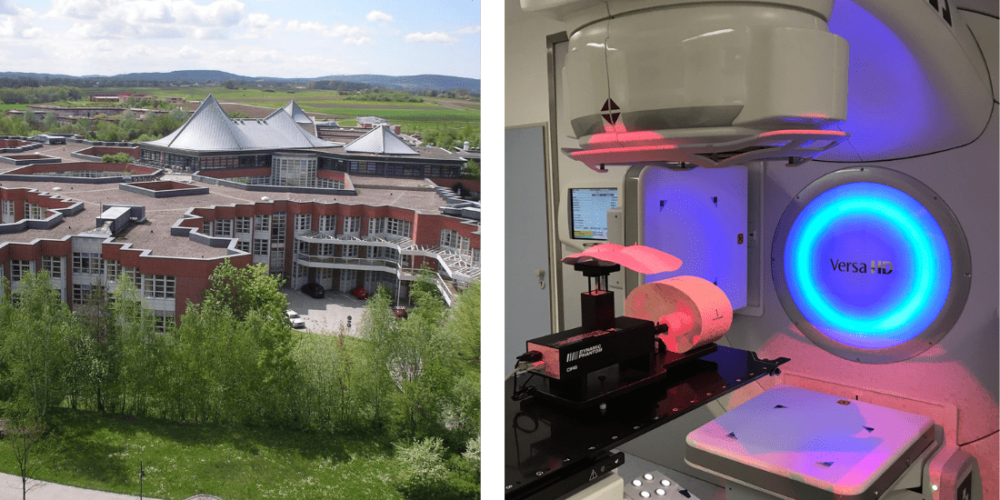The Essentials of SBRT with SGRT

Mathias Dierl is Head of Medical Physics at Klinikum Bayreuth, in Bavaria Germany. They first started using SGRT in 2016 and they now use it to treat more than 1400 patients every year.
In this Q&A session, he discusses the impact SGRT has had on clinical practice, at first just in its use for Stereotactic Body Radiation Therapy (SBRT, also known as SABR) but eventually for every patient and every fraction.

Tell us about your experience with SBRT with SGRT.
“In Germany, we define Stereotactic Body Radiation Therapy (SBRT) as any radiation therapy involving not more than 10 fractions, with a comparatively high dose, enabling you to kill cancer cells in a small volume area. Typically, this can be three fractions of 15 gray, or one times 20 gray, or – at the upper limit – 10 times four gray.
How does SGRT help with tracking ‘moving targets’?
“So this is where Deep Inspiration Breath Hold (DIBH) comes in. It’s not always feasible to perform an accurate treatment if the target is moving. Limiting movement is key to getting the accuracy you need for SBRT, and this applies not just to the lungs – where there will of course be the greatest movement – but also to treatments involving the liver, pancreas, ribs and kidneys. All of those organs move with the breathing cycle.
A lot of physicians are not aware of breathing motions and their amplitude. Some will assume that if a tumor is located in the center of the lung that it will not move during radiation treatment. I’ve seen a lot of moving targets in the center of the lung. You cannot track that movement just by looking at a CT scan.
The old method of managing this – to enable you to increase the dose and limit your volume – would be to physically prevent the patient from moving as much as possible. For example in brain-SRS cases, 15 or 20 years ago, we used to put screws into the skull of a patient so we could fix the head directly to the table. It was bloody work. Some years later we used to apply pressure to the abdomen to limit the inhale-volume in lung treatments. Today this is still a commonly used technique to limit movement. But this also limits the number of patients you can treat, because not everyone will be able to stand this kind of pressure and some will simply refuse to accept it because of the discomfort.”
So what prompted your change to SGRT for your SBRT patients?
The advantage of the AlignRT system is that the reaction time is much faster. And the tolerances are objective – you can measure them in millimeters and not based on a guess from what you see on a camera. It’s no longer dependant on subjective feelings. As a physicist that’s very satisfying for me. There are no distractions from the patients or colleagues or by anything really. The system is always watching and the accuracy and reaction time is much better. “The old system of motion management was to look at the output from a video camera and guess how much movement there was. Is it too much? Or is it acceptable? And you had to rely on your reaction time, to press a button quickly if you wanted to interrupt the beam.
Motion management is becoming really crucial for the effectiveness of SBRT, as you must keep the safety-margins so small to limit the volume that is treated with a very high dose in a small number of sessions.
For some patients that are not able to reach a stable level of inspiration repetitively it is the only chance to get a really gentle and preservative treatment to offer “real gating”, turning the beam on and off according to the phase of the breathing cycle – allowing the patient to breath freely during the whole session.”
If SGRT is such an improvement in your view, why do you think some clinics haven’t taken it up yet?
“If you want to introduce a new technique, like SGRT, to your hospital, it requires investment. It’s not just money, you have to invest time and manpower. And some hospitals will feel that they do not really have the manpower to introduce new techniques. You do have to invest time and money and there is a learning curve.
But the advantages make it worth it. Our clinic is located in a part of Germany where there is a lot of competition. We have to convince our customers – our patients – to choose us as a partner for their fight against cancer because of our high standards and the quality of our treatments. That’s how we convinced our CEO, that – in order to compete in this market – we had to have really high standards of care. And offering SGRT is a consequent part of this strategy.
Our clinic does see a benefit on the financial side. I think we have attracted a lot of patients to our hospital that we would not see if we didn’t use SGRT for our breast cancer patients and SBRT with SGRT for our other patients, they would simply drive by Bayreuth and not be treated here.”
You make it clear that there is an adoption curve. But on a day-to-day basis, is the system complex to maintain?
“You can gain experience by visiting other centers or by learning from experienced users, how to delineate the target volume, how to take care of effects that that could limit the total dose you could offer the patients.
The preparation time to use our SGRT system is close to zero. It’s there to use with the majority of patients throughout the day. You don’t have to clean it because the system is contactless – it’s never in contact with the patient. It is a different workflow than we had before, but we’ve had no issues. The daily Quality Assurance is done by our RTTs and it takes around two minutes per treatment system each day. They are all happy with the system – the staff and the patients.”
Tell us about the overall difference SBRT with SGRT has made in your practice.
“SGRT is a very effective motion management tool for normal fractionated treatments, but its effectiveness becomes even greater with high doses such as in SBRT, because you have to be much more precise to offer these extraordinarily high doses to the patient. The workload for our team to use SBRT is higher, but the smaller number treatment sessions compensate for that easily. A normal fractionated lung treatment might take longer each time, but it might be for only three fractions. You will gain a lot of patients and those patients can benefit from the comfort and from having fewer fraction treatments.
I’ve seen a lot of patients over the past few decades that have limited their survival chance because they saw the old way of treatment as being so uncomfortable. It’s really a pity because then the comfort of the patient is linked to the to the survival of the patient. If your clinic uses SGRT, it’s far less invasive. You don’t have to put screws inside their skull, or apply pressure on the patient to hinder their breathing cycle. All of that can be really harmful or painful to the patient. A relaxed and comfortable patient is an easy to treat patient. We believe this system is working and it is beneficial for our patients.”
Find out more about SBRT with SGRT
Sign up for the SGRT Community’s bitesize course on SBRT with SGRT
Get in touch
Ready to take the next step?
Vision RT’s family of SGRT solutions guide radiation therapy for better patient care at every step: Sim, Planning, Treatment and Dose. Whether you’re looking for a quote, a product demo (virtual or in-person) or just more information, please get in touch.